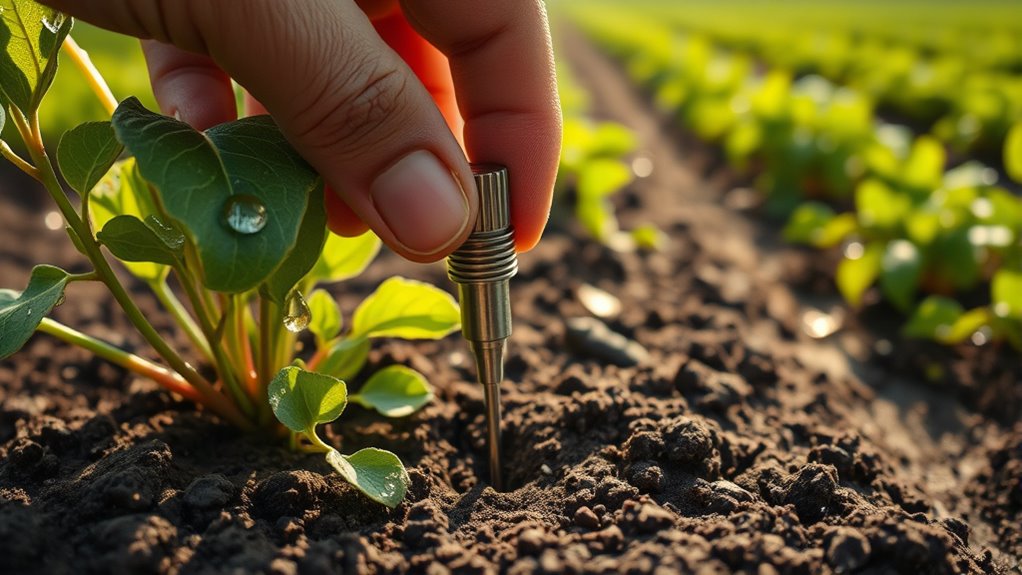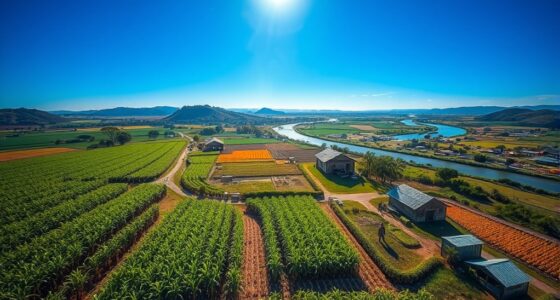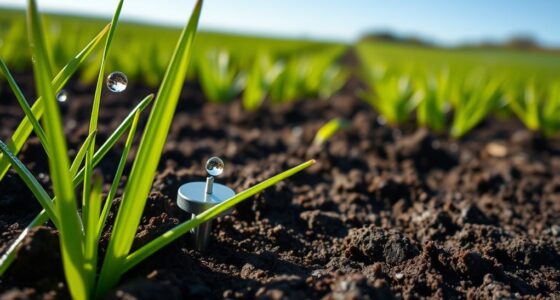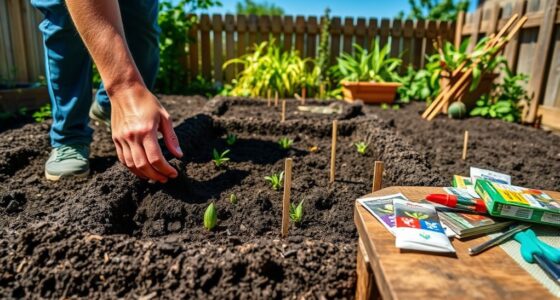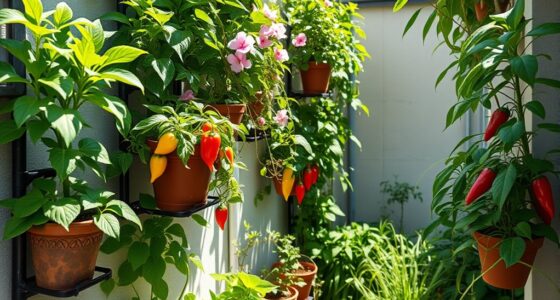Soil moisture sensors can be a smart investment if you want to optimize your watering and promote healthier plants. They provide real-time data on soil water levels, helping you avoid over or underwatering, which saves water and time. Although initial costs and calibration are considerations, their ability to improve plant health and efficiency makes them worth it for many gardeners. Keep exploring to discover how choosing the right sensor can make a difference for your garden.
Key Takeaways
- Soil moisture sensors provide real-time data, helping optimize watering and improve plant health.
- Proper calibration and soil property understanding enhance measurement accuracy and reliability.
- They can save water and reduce maintenance efforts, making them cost-effective long-term investments.
- Sensor durability and environmental factors may require regular maintenance or replacement.
- For small gardens, affordable models offer significant benefits with proper use and calibration.
How Do Soil Moisture Sensors Work?
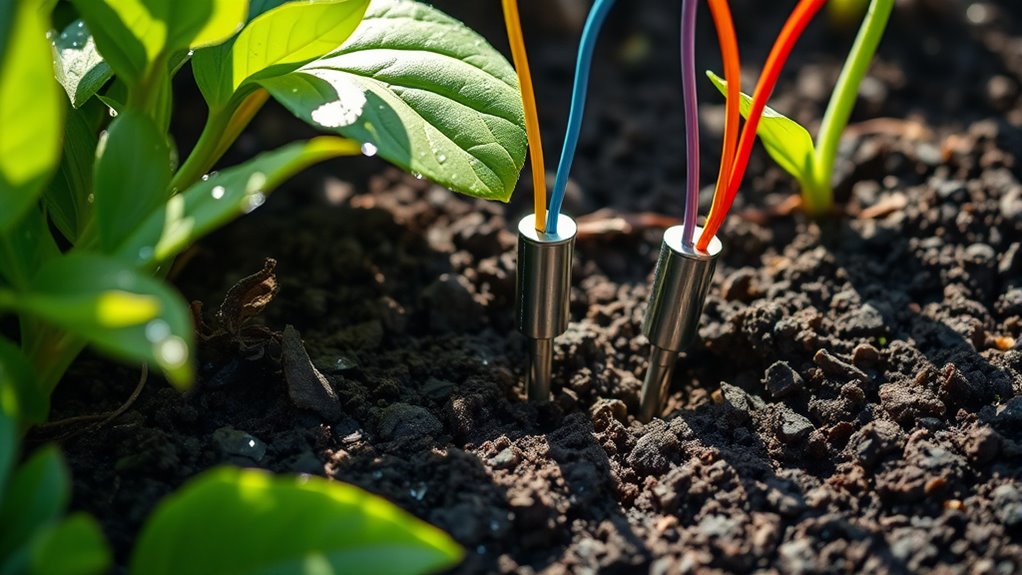
Soil moisture sensors work by measuring the amount of water present in the soil. To get accurate readings, you need to perform sensor calibration, ensuring the device is properly adjusted for your specific soil type. This step helps improve the reliability of data interpretation, so you understand exactly how moist the soil is. Once calibrated, the sensor sends electrical signals or digital data that reflect soil moisture levels. These signals are then translated into meaningful information, like percentage moisture content or volumetric water content. Proper calibration is essential because it accounts for soil differences, making the data you collect more precise. Additionally, understanding soil properties can further enhance the accuracy of moisture measurements and improve your overall irrigation strategy. Incorporating knowledge about soil texture and composition can help tailor your watering practices more effectively. Recognizing how soil conductivity influences sensor readings can also assist in refining measurement accuracy. With clear data interpretation, you can better decide when and how much to water your plants or crops, optimizing growth and resource use.
Benefits of Using Soil Moisture Sensors
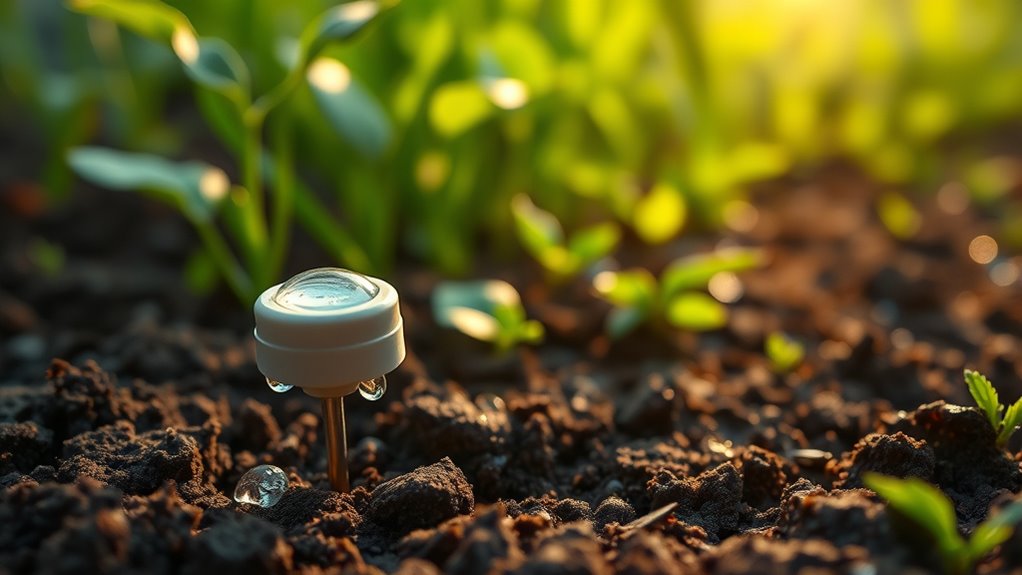
Using soil moisture sensors offers numerous advantages that can substantially improve your watering practices. By providing real-time data, these sensors help you maintain ideal soil moisture levels, which directly benefits plant health. When plants receive the right amount of water, they grow stronger, resist diseases better, and produce healthier yields. Additionally, soil moisture sensors promote water conservation by preventing overwatering and reducing waste. You’ll use water more efficiently, saving money and helping the environment. These sensors also save you time and effort, as you no longer need to guess or rely on visual cues to determine when to water. Incorporating advanced sensing technology can further optimize your watering schedule and improve overall plant care. Moreover, many soil moisture sensors are compatible with smart home systems, allowing for even more automation and remote monitoring. Some sensors even feature solar-powered options, making them more sustainable and reducing maintenance needs. The availability of local resources can also influence the effectiveness of your soil moisture management. Overall, integrating soil moisture sensors into your gardening routine ensures healthier plants while making your watering smarter and more sustainable.
Potential Drawbacks and Limitations
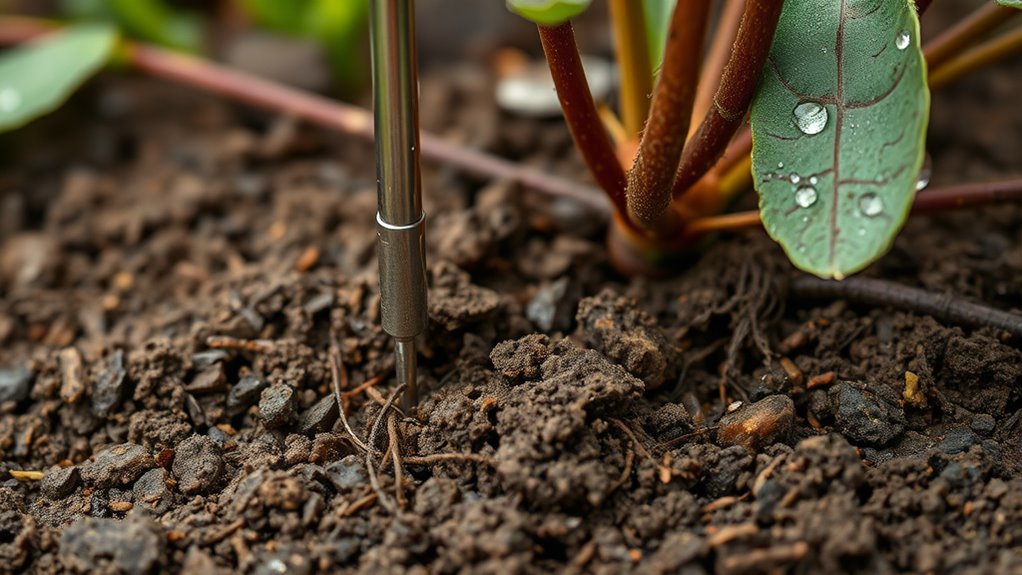
While soil moisture sensors offer many benefits, they also come with certain limitations that you should consider. One key issue is sensor accuracy, which can vary depending on the device quality and calibration. Inaccurate readings may lead you to over- or underwater your plants. Additionally, device durability is a concern; some sensors aren’t built to withstand harsh weather or soil conditions, leading to potential breakdowns or false readings over time. You might find that sensors need frequent maintenance or replacement, increasing costs and effort. Also, environmental factors like soil type, temperature, and salinity can affect sensor performance. Before investing, weigh these drawbacks to ensure the sensor’s reliability matches your gardening needs and conditions. Moreover, AI vulnerabilities highlight the importance of selecting sensors with robust safety measures to prevent potential malfunctions. Considering sensor calibration can help improve accuracy and longevity, and staying informed about technological advancements can assist in choosing more reliable options. Additionally, understanding the specific soil type of your garden can help optimize sensor performance and accuracy.
Are They Cost-Effective for Small-Scale Gardens?
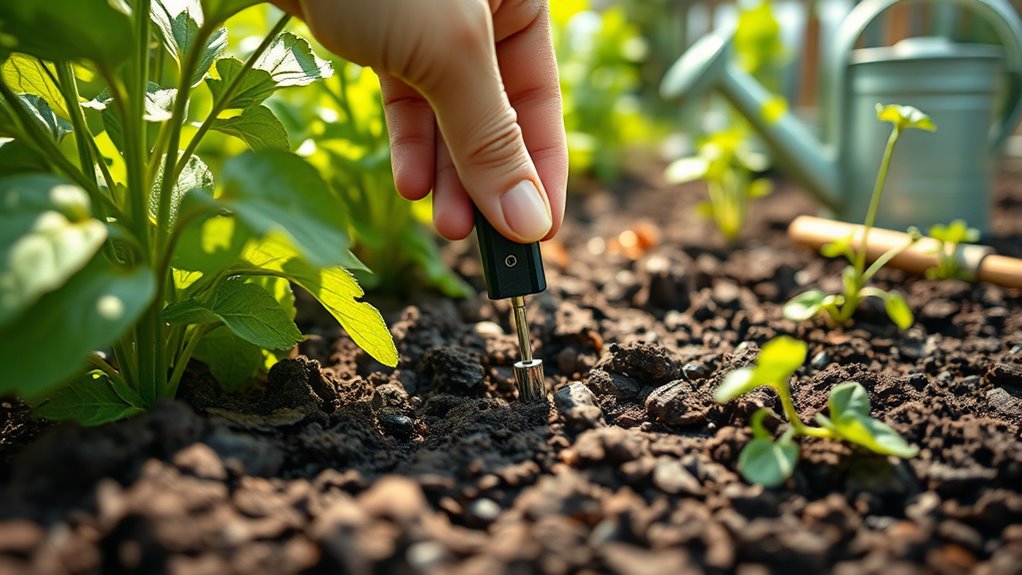
For small-scale gardens, soil moisture sensors can be a cost-effective way to monitor watering needs, but their affordability depends on your specific setup. When weighing the cost comparison, you’ll want to evaluate the initial expense against potential water savings and healthier plants. Keep in mind that installation challenges can influence overall value; simple models are usually easy to set up, but more advanced sensors may require technical skills or additional tools. Here are some key points to consider:
- Basic sensors are typically affordable and straightforward to install
- Higher-end models offer advanced features but can increase costs
- Long-term savings from optimized watering might outweigh upfront expenses
Ultimately, if you’re willing to navigate installation challenges, soil moisture sensors can be a worthwhile investment for small gardens. Incorporating insights from The Creative Spark can also inspire innovative ways to integrate technology into gardening practices for enhanced efficiency.
Tips for Choosing the Right Soil Moisture Sensor
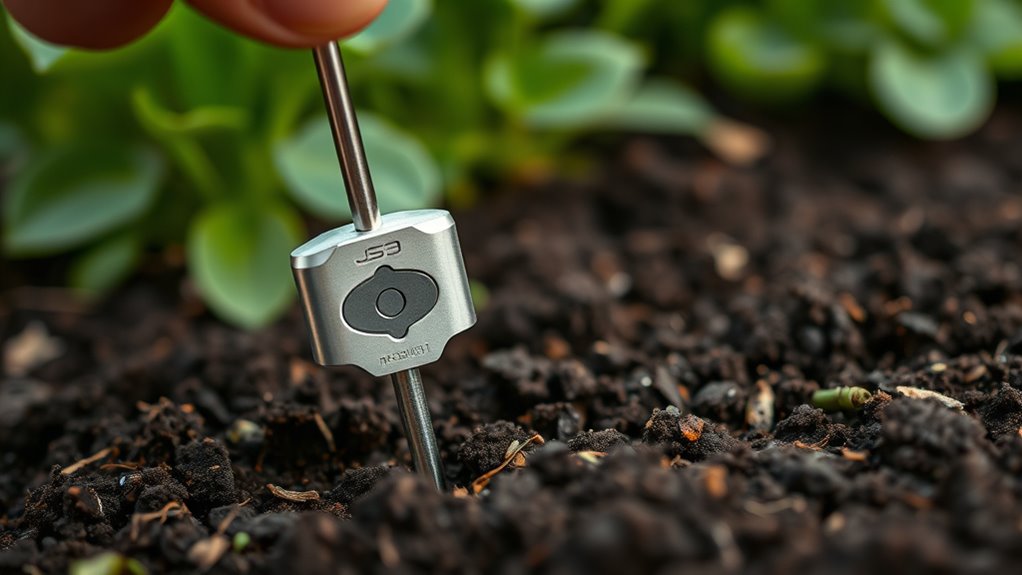
Choosing the right soil moisture sensor begins with understanding your garden’s specific needs and budget. Consider whether you need a simple, analog device or a more advanced digital sensor that offers real-time data. Pay attention to sensor calibration—accurate calibration guarantees reliable readings, so check if the sensor is easy to calibrate or comes pre-calibrated. Think about how you’ll interpret the data; some sensors provide straightforward moisture levels, while others offer detailed analytics. If you’re a beginner, opt for user-friendly models with clear instructions and easy data interpretation. Also, consider durability and waterproof features for outdoor use. Proper risk assessment can help identify potential vulnerabilities in your watering system and ensure you select a reliable sensor. Additionally, understanding the efficiency of hydrogen fuel cells can inspire you to choose energy-efficient devices for your garden tools. By focusing on calibration ease and data clarity, you’ll choose a sensor that helps you make informed watering decisions and keeps your garden thriving. Incorporating remote monitoring options can further enhance your ability to manage watering schedules from anywhere, saving time and effort.
Frequently Asked Questions
How Long Do Soil Moisture Sensors Typically Last Before Needing Replacement?
The sensor lifespan varies depending on the quality and usage, but generally, you can expect soil moisture sensors to last around 3 to 5 years. Regular maintenance and careful handling can extend their replacement frequency, ensuring accurate readings. Keep an eye on calibration and signs of wear, so you know when it’s time for replacement. Proper care helps maximize your sensor’s effectiveness and reduces the need for frequent replacements.
Can Soil Moisture Sensors Be Used Effectively in All Soil Types?
Soil type critically shapes sensor success. You’ll find some sensors suit sandy, loamy, or clay soils, but others struggle with specific conditions. When choosing, consider sensor compatibility with your soil type to guarantee accuracy. You can confidently use sensors in various soils if you match the sensor’s design and features to your soil’s unique characteristics, maximizing moisture monitoring and making your watering efforts wise and efficient.
Do Soil Moisture Sensors Require Regular Calibration for Accuracy?
You might wonder if soil moisture sensors need regular calibration for accuracy. In most cases, sensor maintenance includes monitoring calibration frequency, especially if you notice inconsistent readings. While some sensors are factory-calibrated and require little adjustment, others benefit from periodic calibration to stay precise. Regularly checking and recalibrating ensures your sensor provides reliable data, helping you make better irrigation decisions and optimize water usage.
Are There Specific Brands or Models Recommended for Beginners?
Imagine you’re starting your garden; a beginner-friendly sensor like the Vegetronix VH400 is ideal. It requires minimal sensor calibration, making setup easy, and offers waterproof durability for outdoor use. This model is recommended because it’s reliable and simple to maintain. For beginners, choosing sensors with clear calibration instructions and waterproof features guarantees accurate readings and durability, helping you optimize watering without hassle.
How Do Environmental Factors Like Temperature Affect Sensor Readings?
Environmental influence, like sensor temperature, can impact your soil moisture readings. When the temperature rises or drops markedly, it may cause sensor inaccuracies because most sensors are sensitive to temperature changes. To get reliable data, you should consider how sensor temperature fluctuates and possibly calibrate your sensor regularly. Keep in mind that controlling environmental influence, such as shielding sensors from direct sunlight or extreme weather, helps maintain accurate readings.
Conclusion
Soil moisture sensors can truly revolutionize how you care for your garden, turning guesswork into precision. While they might seem like a small investment, their impact is massive—helping you save water, time, and effort. If you want to avoid the chaos of over- or underwatering and give your plants the best shot at thriving, these sensors are definitely worth considering. Don’t let your garden suffer in silence—equip yourself with the tools to make it flourish!

